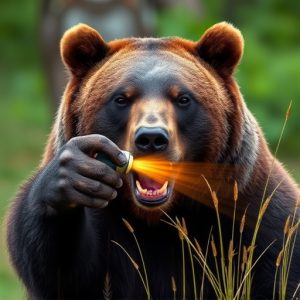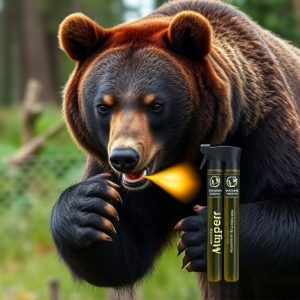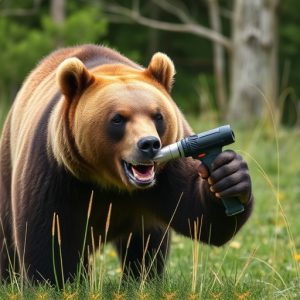Mastering Alaska Bear Spray Fog Pattern for Optimal Defense
Maximizing the effectiveness of bear spray requires understanding fog pattern dynamics, including id…….
Maximizing the effectiveness of bear spray requires understanding fog pattern dynamics, including ideal application distance (20-30 feet), impact of wind direction, humidity, temperature, terrain, and foliage. Best practices involve maintaining a safe distance, aiming at the bear's face and body, and being mindful of environmental conditions for optimal deployment, especially in Alaska's varied landscapes where context-specific knowledge is crucial.
In Alaska, understanding the dynamics of bear spray fog patterns is crucial for effective wildlife management and human safety. This comprehensive guide delves into the science behind bear spray dispersion, exploring factors that dictate the optimal distance for application. From identifying key variables to best practices and real-world case studies, we equip readers with essential knowledge on utilizing bear deterrents efficiently. Discover the secrets to maximizing the impact of bear spray at the ideal range, ensuring both safety and environmental stewardship in Alaska’s diverse landscapes.
- Understanding Bear Spray Fog Pattern Dynamics
- Factors Influencing Optimal Distance for Application
- Best Practices for Effective Bear Deterrent Use
- Case Studies: Analyzing Successful Deployment Scenarios
Understanding Bear Spray Fog Pattern Dynamics
Understanding Bear Spray Fog Pattern Dynamics is key to ensuring its effectiveness in bear encounters. The optimal distance for bear spray is typically around 20-30 feet (6-9 meters), but this can vary based on environmental conditions and the bear’s behavior. In ideal conditions, the spray forms a dense fog that can quickly incapacitate or deter an attacking bear. This fog pattern creates a barrier of capsaicin, the active ingredient in bear spray, by suspending it in the air.
However, factors like wind direction, humidity, and temperature can influence how the spray disperses. A headwind can carry the spray away from you, while a tailwind might cause it to blow back towards you. High temperatures or low humidity can lead to faster evaporation, reducing the fog’s effectiveness. In dense foliage or narrow spaces, the spray may not spread as widely, decreasing its coverage area. Knowing these dynamics allows users to adjust their position and application technique for optimal results during a bear encounter.
Factors Influencing Optimal Distance for Application
When considering the optimal distance for applying bear spray, several factors come into play. The primary concern is ensuring that the spray reaches the bear’s face and eyes effectively. Wind direction and speed significantly influence the fog pattern’s range and dispersion. A gentle breeze can help distribute the spray more evenly, increasing the chances of direct contact with the bear. Conversely, strong winds may cause the spray to blow back or spread too widely, reducing its effectiveness.
Terrain and topography also play a crucial role. In open areas, the spray can travel farther without obstacles. However, in dense forests or rugged terrain, the distance is often shorter due to obstructions and varying wind patterns at ground level. Understanding these variables helps users determine the appropriate moment and range for deploying bear spray during encounters, maximizing its potential as a deterrent.
Best Practices for Effective Bear Deterrent Use
When using bear spray as a deterrent, understanding and adhering to best practices is crucial for ensuring its effectiveness. One of the key factors is maintaining the optimal distance for application. Studies show that the ideal range for successful deployment is approximately 20-30 feet (6-9 meters) away from potential bear encounters. At this distance, the fog pattern covers a wide area, creating a protective barrier without unnecessarily spraying nearby objects or people.
Proper usage involves aiming the nozzle at the bear’s face and body, releasing a quick burst of spray. It’s important to remember that movement should be minimal during application to maintain accuracy. Users should also be conscious of wind direction, ensuring it doesn’t carry the spray back towards them or other individuals nearby. Regular practice in controlled environments can help individuals become more comfortable and confident in their ability to use bear spray effectively when needed.
Case Studies: Analyzing Successful Deployment Scenarios
In analyzing successful deployment scenarios, understanding the optimal distance for bear spray is crucial. Case studies from across Alaska reveal that the effective range varies based on several factors, including wind conditions, terrain, and the specific spray pattern of the product used. In ideal conditions, with calm winds and flat terrain, many professionals recommend an optimal distance of 20 to 30 feet (6 to 9 meters) for maximum impact. This range ensures that the spray reaches the bear’s face and eyes, neutralizing its ability to attack.
However, in more challenging environments, such as steep slopes or windy areas, this distance can be reduced significantly. For instance, studies have shown that in high-wind conditions, the effective range of bear spray may drop to as low as 10 feet (3 meters). Conversely, in flat, open spaces with minimal obstacles, the range can extend up to 50 feet (15 meters) or more. These variations underscore the importance of context in determining the optimal distance for deployment, ensuring that individuals are equipped with the knowledge and tools necessary to protect themselves effectively in Alaska’s diverse landscapes.
Understanding the fog pattern dynamics of bear spray is key to ensuring its effective use. By grasping the factors influencing the optimal distance for application, following best practices, and learning from successful deployment scenarios, individuals can maximize the deterrence capabilities of bear spray in Alaska. Remember that proper usage techniques and knowledge of environmental conditions are crucial for protecting both oneself and the bears’ natural habitats.


